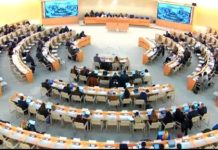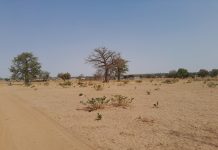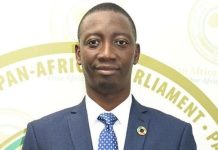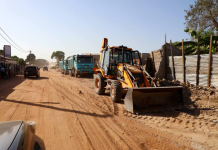By: Sheikh Alkinky Sanyang
Hatab Camara, Mangrove Restoration Assistant of the NEA/UNDP/GEF Coastal resilience project has called on the villagers in the Lower
River Region (LRR) community of Kiang Kantong Kunda to plant as many
trees as possible particularly mangroves as part of efforts to restore the
already lost mangrove vegetation that Kiang West has enjoyed
for ages.He said mangroves serve as environmental indicators while they equally
provide a home to many aquatic lives, breeding spots for young
juvenile fish and above all a carbon sink. Camara recently made these
comments during the project`s mangrove restoration planting exercise
in Kantong Kunda, where the occasion was graced by the entire village
populace who took ownership of the initiative in regaining their old glory by planting
thousands of seedlings.
Counting on their motivation to embark on this restoration exercise,
the local UNDP expert disclosed that along the Bintang Bolong
tributary from Bwiam in WCR to Sandeng in LRR, there is a presence of
high mortality rate of mangroves on one hand and salt intrusion on the
other. He said even the stock of fish these communities
enjoy is getting scarce. In an effort to help those communities get
back on to their livelihood support systems, the project decided to
restore the lost mangroves.
He said planting Mangroves is not difficult provided that one observes
some basic guidelines that will lead to a successful sustainable
restoration program. On the pre-conditions for this successful
exercise, Camara revealed that the project has conducted an initial
survey of representative habitats in areas close to the chosen site,
identified and selected mangrove species, types of substrate, depths
of water at high and low tides, salinity of water trapped in mangrove
mud at low tide, among lots of other researches conducted before any
exercise.
“We are happy to assist local vulnerable communities with technical
support, training and sensitization in any way possible but the
ultimate responsibility of doing the work will reside in the villagers
themselves,” Camara lamented, reiterating that it’s the duty and
responsibility of all to keep our marine ecologies protected and
conserved.
Commenting earlier, Molifa Ceesay a village forest committee member
locally coordinating the exercise noted that the project`s foresight
in helping them regenerate their vegetation cover and ecosystem is to
prepare them to fight climate change through carbon print. Counting on
the numerous benefits derive from vegetation, the village elder
called on the young generation to positively contribute to the
restoration of their lost forest covers and create new woodlots to
reduce the stress loaded on the remaining diminishing forest cover. He
therefore called on his compatriot villagers to jealously guard their
forest covers and sustainably use them for the benefit of their unborn
future generations.
The village women head Mabinta Ceesay disclosed that it is
their responsibility to galvanize popular will for the restoration of
the entire wetland area, promising that with time the remaining
unplanted area would be restored.
The National Environment Agency (NEA) is implementing the United
Nations Development Program (UNDP) and Global Environment Facility
(GEF) Least Developed Countries Development Funds (LCDF) Project
“Enhancing Resilience of Vulnerable Coastal Areas and Communities to
Climate Change in the Republic of The Gambia”. The objective of the
project is to reduce Gambia’s vulnerability to sea-level rise and
associated impacts of climate change by improving coastal defences and
enhancing adaptive capacities of coastal communities.
]]>
Coastal resilience project has called on the villagers in the Lower
River Region (LRR) community of Kiang Kantong Kunda to plant as many
trees as possible particularly mangroves as part of efforts to restore the
already lost mangrove vegetation that Kiang West has enjoyed
for ages.He said mangroves serve as environmental indicators while they equally
provide a home to many aquatic lives, breeding spots for young
juvenile fish and above all a carbon sink. Camara recently made these
comments during the project`s mangrove restoration planting exercise
in Kantong Kunda, where the occasion was graced by the entire village
populace who took ownership of the initiative in regaining their old glory by planting
thousands of seedlings.
Counting on their motivation to embark on this restoration exercise,
the local UNDP expert disclosed that along the Bintang Bolong
tributary from Bwiam in WCR to Sandeng in LRR, there is a presence of
high mortality rate of mangroves on one hand and salt intrusion on the
other. He said even the stock of fish these communities
enjoy is getting scarce. In an effort to help those communities get
back on to their livelihood support systems, the project decided to
restore the lost mangroves.
He said planting Mangroves is not difficult provided that one observes
some basic guidelines that will lead to a successful sustainable
restoration program. On the pre-conditions for this successful
exercise, Camara revealed that the project has conducted an initial
survey of representative habitats in areas close to the chosen site,
identified and selected mangrove species, types of substrate, depths
of water at high and low tides, salinity of water trapped in mangrove
mud at low tide, among lots of other researches conducted before any
exercise.
“We are happy to assist local vulnerable communities with technical
support, training and sensitization in any way possible but the
ultimate responsibility of doing the work will reside in the villagers
themselves,” Camara lamented, reiterating that it’s the duty and
responsibility of all to keep our marine ecologies protected and
conserved.
Commenting earlier, Molifa Ceesay a village forest committee member
locally coordinating the exercise noted that the project`s foresight
in helping them regenerate their vegetation cover and ecosystem is to
prepare them to fight climate change through carbon print. Counting on
the numerous benefits derive from vegetation, the village elder
called on the young generation to positively contribute to the
restoration of their lost forest covers and create new woodlots to
reduce the stress loaded on the remaining diminishing forest cover. He
therefore called on his compatriot villagers to jealously guard their
forest covers and sustainably use them for the benefit of their unborn
future generations.
The village women head Mabinta Ceesay disclosed that it is
their responsibility to galvanize popular will for the restoration of
the entire wetland area, promising that with time the remaining
unplanted area would be restored.
The National Environment Agency (NEA) is implementing the United
Nations Development Program (UNDP) and Global Environment Facility
(GEF) Least Developed Countries Development Funds (LCDF) Project
“Enhancing Resilience of Vulnerable Coastal Areas and Communities to
Climate Change in the Republic of The Gambia”. The objective of the
project is to reduce Gambia’s vulnerability to sea-level rise and
associated impacts of climate change by improving coastal defences and
enhancing adaptive capacities of coastal communities.
]]>





















